Timney Triggers will make your rifle more accurate.
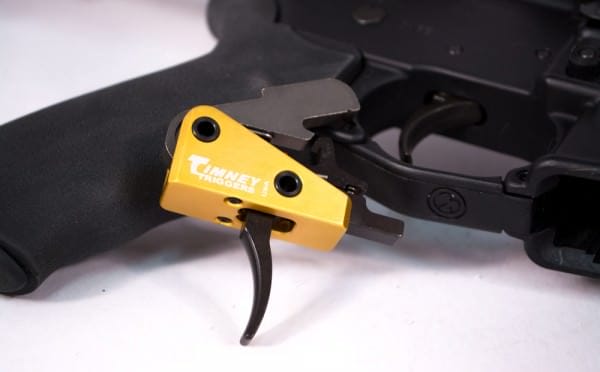

USA –-(Ammoland.com)- Gun shop wisdom says a Timney Triggers makes all the difference.
It should be obvious that replacing the trigger doesn’t have any physical impact on a rifle’s accuracy. It’s not like it synchronizes barrel harmonics to the tune of “You’re So Vain” or anything. A trigger doesn’t touch the barrel or impact flight path, yet everyone swears it makes a rifle more accurate.
That’s kind of true. But it doesn’t make the rifle more accurate, it makes it easier for you, the shooter, to get the best accuracy that the rifle is capable of. This is an important distinction.
The reason is that pesky physics thing. When a rifle takes several pounds of pressure to break the shot, and the rifle itself only weighs several pounds, it’s gonna want to move, at least a little bit. A good trigger, with a smooth action and reasonably low pull weight, is going to make it easier for you to break the shot without moving the sight alignment of the rifle. When you’re trying to extract every last fraction of an inch of accuracy, a little bit of unwanted movement means a lot on the target.
According to John Vehr, President of Timney Triggers, “There is only one reason to upgrade a trigger in a firearm – to make you more accurate with the firearm. A great trigger will allow you to become more accurate by eliminating physical factors like drag, creep and heaviness – Less movement equals better accuracy. A great trigger will allow the shooter to make the act of pulling the trigger more of a mental decision that a physical decision. A great trigger is an extension of the mind and should break exactly when the shooter calls for the shot.”
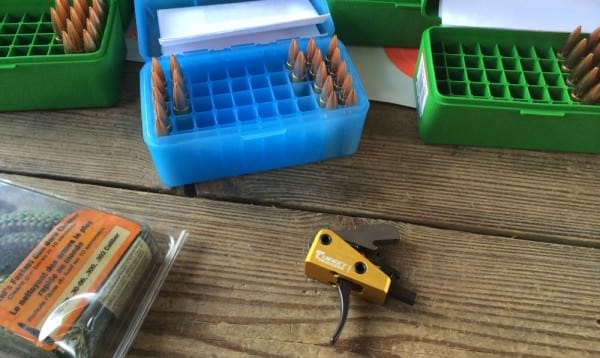
Gaining more practical accuracy by using a custom trigger sounds great in theory, but I wanted to put it to the test in a quantifiable way.
I decided to take two rifles of proven quality and accuracy, but with less than optimal triggers, and test their accuracy before and after a trigger upgrade. The folks at Timney Triggers sent me an AR-15 Competition trigger for the test. This trigger, the 3 pound 667 model, is a self-contained unit with drop-in installation.
My thought for the test was simple. Shoot groups of 5 shots each with each rifle with its standard factory trigger. While at the range, swap the trigger for the Timney AR-15 Competition, and reshoot the groups. Same ammunition, same rest, same day, same atmospheric conditions and same shooter.
When all was done, I figured on applying some “common core” math to compare the average group sizes before and after. Then I realized that this article was due in 2014, so I skipped the common core stuff and added, subtracted and averaged the old fashioned way.
First, let’s look at the before situation.
The Rock River Arms LAR-6.8 upper combined with standard LAR-15 lower has, let’s just say, a challenging trigger. Take up is ⅛ inch or so of heavy, high friction grit – kind of like rubbing two bricks together. And that’s followed by an 8 pound pull. Nonetheless, this has proven itself a very accurate rifle, so I figured it would be perfect as a trigger upgrade test candidate.
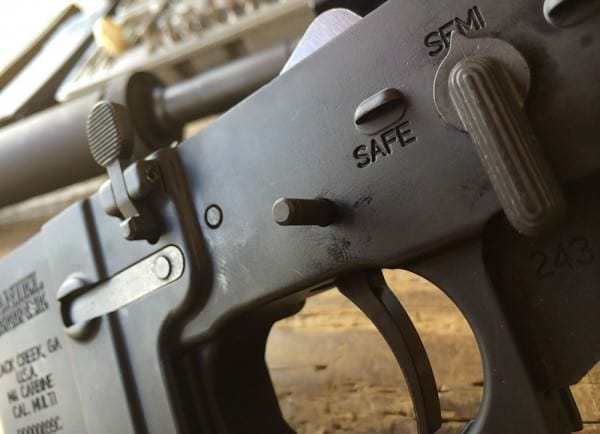
The Daniel Defense DDM4v5 300 Blackout starts off with a better trigger than the Rock River Arms, but that’s not saying a whole lot. It’s got a gritty, high-friction take-up, but only requires about 5 ½ pounds of pressure to break. Daniel Defense makes great rifles and the barrels are cold-hammer forged and consistent, so I figured this rifle was another great candidate for a trigger upgrade.
Note to self: Every time you buy a nice AR rifle in the future, don’t be a cheapskate. Order it with the Timney Triggers upgrade option right off the bat.
Fortunately, installation of the Timney AR-15 Competition trigger is easy. I did it at my outdoor range, and there’s not even running water there.
The process is simple:
- Separate the upper and lower receivers.
- Punch out the two pins that hold the trigger components in place.
- Remove the grip so you can take pressure off the safety detent pin.
- Remove the safety.
- Drop the Timney Trigger group in place.
- Reinstall the safety, detent, spring and grip.
- Reinstall the two trigger group pins.
- Tighten two set screws which lock the trigger group in place against the trigger group pins.
- Reattach upper and lower receivers.
On to the test …

I first shot before groups with factory triggers. To minimize variables, I used carefully constructed hand loads with proven accuracy histories.
I used two different 300 AAC Blackout loads, one with 125 grain Sierra Matchking projectiles and the other with 135 grain Sierra Matchking projectiles. For each projectile type, I shot multiple 5-shot groups at 100 yards and calculated the average.
For the 6.8 Remington SPC, I also used an115 grain Sierra Matchking custom load. I also shot multiple 5-shot groups from 100 yards and calculated the average.
Next, I installed the new Timney Trigger in each rifle and re-shot the series of 5-shot groups, again at the same 100 yard distance.
Here’s what I found in terms of the before and after.
| Load | Factory Trigger | Timney Trigger Upgrade |
| 300 Blackout 125 grain Matchking average | 1.69” | 0.970” |
| 300 Blackout 135 grain Matchking average | 1.37″ | 1.007″ |
| 6.8 Remington SPC 115 grain average | 1.75” | 1.47” |
I have to admit, the results surprised me. I was shooting from a Blackhawk! Sportster Titan III rifle rest. The rifle was in a solid position, my optics were powerful enough to maintain a precise hold point at 100 yards, and I took my time with the trigger. Yet still, on a percentage basis, I observed better accuracy when using the Timney Competition Trigger.
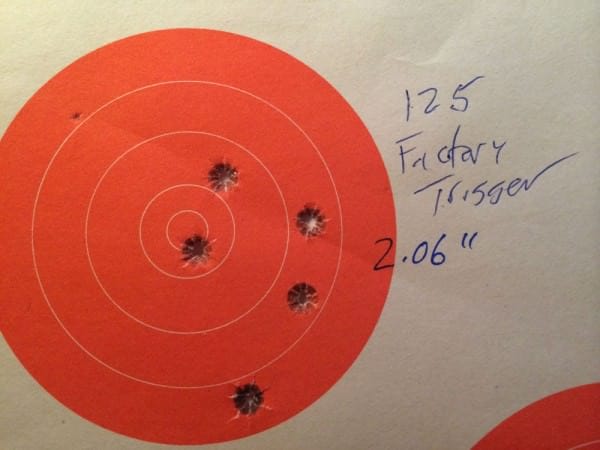
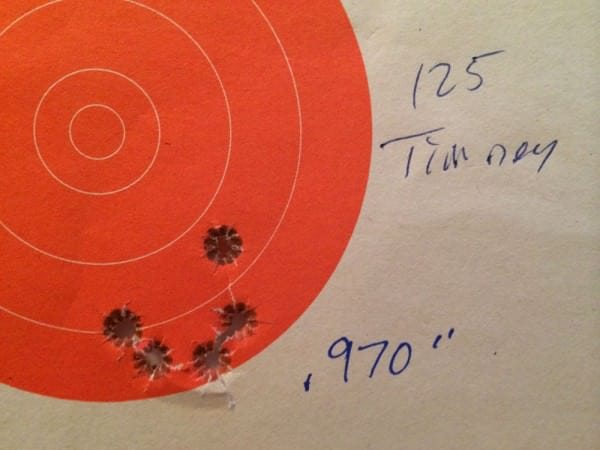
I have to wonder, if the right trigger can make this kind of difference from a solid rest position, how much would it positively impact offhand shooting?
About
Tom McHale is the author of the Insanely Practical Guides book series that guides new and experienced shooters alike in a fun, approachable, and practical way. His books are available in print and eBook format on Amazon. You can also find him on Google+, Facebook, Twitter and Pinterest.


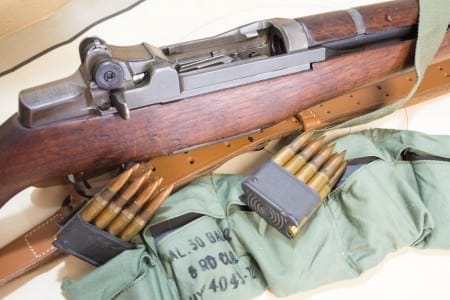
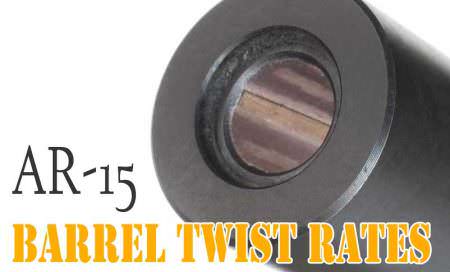

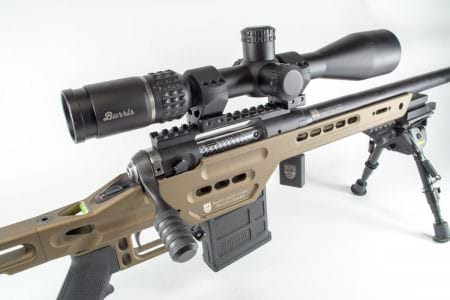
I replaced the trigger in my 788 remington .243 primarily for safety reasons but my 100yd. groups went from 1.25 inches to .60 inches, I am now getting ready to install a Timney trigger in another 788 Remington, also in the 243. caliber, after shooting my old 788 with the new trigger, my son found and purchased a 788 of his own.
788s are crap, go get you an a model 700, and your accuracy will improve greatly! With a 788, its not just the trigger, its mostly the rifle.
The 788 is a solid action, and can be a very accurate system. The two big failings of Remington’s “poor man’s 700” were the trigger and the stock. Replacing the trigger with a good aftermarket one (Timney is the only company I’m aware of offering such) will make a huge improvement. Hogging out or replacing the factory stock, relieving the forend, and glass-bedding the action will generally make the rifle very competitive with it’s more expensive sibling. There are other improvements that can be made, from minor polishing and fitting, to replacing the barrel, but for the original price plus… Read more »
Haven’t tried the Timney however, I dropped in an American Gold Trigger in my S&W AR Mod 15 with a 6.8 Stag Arms upper. Incredible difference. Worth every single penny (lots of them).
I love my timney trigger I was able to shoot half inch group’s at 100 yards after I installed a timney trigger